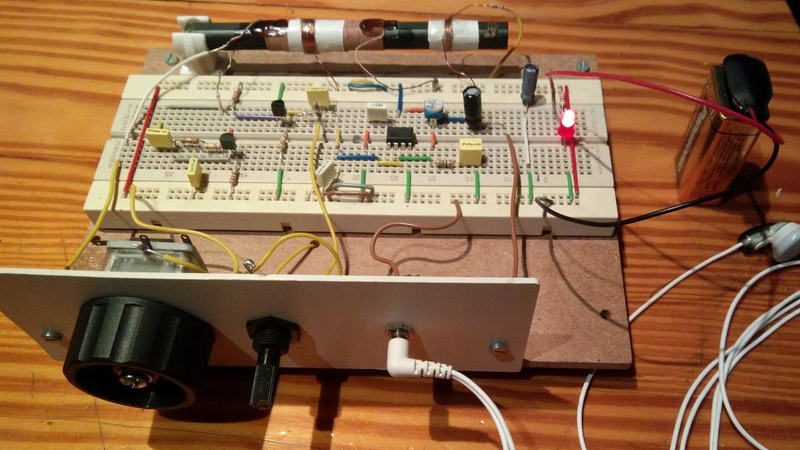Crystal radios used to be the “gateway drug” into hobby electronics. Trouble was, there’s only so much one can hope to accomplish with a wire-wrapped oatmeal carton, a safety-pin, and a razor blade. Adding a few components and exploring the regenerative circuit can prove to be a little more engaging, and that’s where this simple breadboard regen radio comes in.
Sometimes it’s the simple concepts that can capture the imagination, and revisiting the classics is a great way to do it. Basically a reiteration of [Armstrong]’s original 1912 regenerative design, [VonAcht] uses silicon where glass was used, but the principle is the same. A little of the amplified RF signal is fed back into the tuned circuit through an additional coil on the ferrite rod that acts as the receiver’s antenna. Positive feedback amplifies the RF even more, a germanium diode envelope detector demodulates the signal, and the audio is passed to a simple op amp stage for driving a headphone.
Amenable to solderless breadboarding, or even literal breadboard construction using dead bug or Manhattan wiring, the circuit invites experimentation and looks like fun to fiddle with. And getting a handle on analog and RF concepts is always a treat.
[via r/electronics]
















“Trouble was, there’s only so much one can hope to accomplish with a wire-wrapped oatmeal carton, a safety-pin, and a razor blade.”
Unless your name is MacGyver.
*theme music begins playing softly*
You left out mom’s baking accessory, that smooth piece of maple or poplar with oiled finish. That’s where the name breadboard comes from.
I like “reflex radio” as the next step.
Add a high pass filter between the amp and the tuned circuit feedback.
Then, after the detector, feed tha audio into the amp again.
Finally, a low pass filter after the amp provides the audio.
Positive feedback, plus two trips through the amp (at different frequencies)
Ha – I always thought “reflex” and “regenerative” receivers were one and the same thing. You learn something every day. Thank you
If you bump the gain too much, the audio goes rail to rail – impacting the RF signal.
Result: you get a quick lesson in Inter-Modulation Distortion (IMD).
See: http://www.ke3ij.com/reflex.htm
Nice work, I’m not the only regenerative receiver holdout. The regens will rise again! :)
And if you turn the regen up to “11” you get superegeration. The two are usually shown as separate, but Armstrong noticed the effect because he was playing with his regen. Both have advantages and disadvantages.
Then there’s the ever popular (well in some circles, especially decades ago) “supergainer”, which put a converter ahead of a regen detector, so a hybrid of the regen and superheterodyne receivers. Simplicity and complication at the same time.
And don’t forget, Howard Armstrong came up with the regen about 1913, also showing how to generate a signal with a tube (ie an oscillator). The regen was really popular for a while, and much longer as a simple receiver, but even today you can’t do much without an oscillator.
Then about 1918 he came up with the superheterodyne receiver, which solved one problems, but added others. Even today, most receivers are suoerhet, or based on the concept.
And then about 1922, he went back to the regen, because of a patent dispute, and pursued something he’d noticed earlier, which became the superegen receiver. It stabilized the gain of the regen, so there was none of that finicky “right before it oscillated point for most gain” which often fell into oscillation because the antenna blowing in the wind loaded the circuit differently. But it was mostly useful for higher frequencies, and that helped. A shift to a higher frequency would make use of the superegen to stake things out, followed by better equipment. They were still used for cheap walkie talkies a few decades go, and I think still used in some remote control things.
So Armstrong in decade came up with three major receiver types, nothing really replacing them since. Even SDRs often use heterodyning.
Then in the early thirties, he dud work on practical wideband FM, used in broadcast and other places.
I don’t think anyone else involved in radio came up with as many key and major elements as Howard Armstrong.
Michael
Do you know if that patent dispute in 1922 involve Lee DeForrest?
You are correct; Major Armstrong blazed the trail. It’s too bad that others tried to steal this great man’s inventions.
Nice to see regenerative receivers get some love in HaD. They are really ‘elegant’ in that they provide quite remarkable performance using so few components. They are electronic haikus.
That schematic shows European transistor types, but my experience is that you can substitute the ubiquitous 2N3904 or 2N2222 in there and still get decent results.
If you’re hooked, the pinnacle is to build a regenerative receiver with one or two tubes, and retro dials and knobs. Bonus marks for plug-in coils.
Lots more circuits and tips at http://theradioboard.com/.
Try building one of these simple regenerative receiver kits (I’m not affiliated):
http://www.4sqrp.com/ozarkpatrol.php
Best 73’s, Me